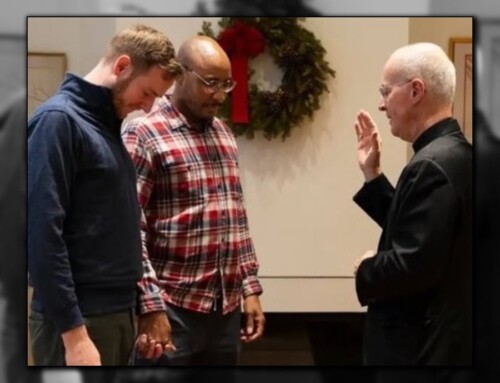In a recent interview with Cardinal Christoph Schönborn of Vienna, he had this to say about a homosexual friend who recently entered into a so-called “stable” gay relationship:
“It’s an improvement,” he said. They share “a life, they share their joys and sufferings, they help one another. It must be recognised that this person took an important step for his own good and the good of others, even though it certainly is not a situation the Church can consider ‘regular’.”
The Church’s negative “judgment about homosexual acts is necessary”, he said, “but the Church should not look in the bedroom first, but in the dining room! It must accompany people.”
But is this an improvement? The facts prove otherwise: in one of the most extensive HIV studies ever performed, it was determined that: “…86% of new HIV infections were occurring within the context of relationships.”1. But according to an even more recent study, the percentage is higher: “…90% within the context of an ongoing sexual partnership.”2. This is tragically the case, as I can testify from the view point of a man who was once in such a relationship, because gay men almost always cease any former semblance of “safe-sex” as soon as they enter into one of these improved situations, as the Cardinal describes them; in addition, part and parcel with this “important step” towards something better is the reality of open relationships within the gay male community: according to one study, over half of those men in a “negotiated” same-sex union have an open relationship, and almost a quarter engaged in unprotected anal sex with someone of an unknown HIV status. (See notes 3-5) Therefore, going into such a relationship, in terms of bodily health, is far from an “improvement;” in reality, it puts the gay man at greater risk since he is lulled into a very false, and ultimately deadly, sense of sexual security.
Also, on an emotional and psychological level, these relationships are never an improvement because they tend to further lock someone into the orientation: for instance, the gay male existence is a constantly restless quest for personal fulfillment though sex. While inside a seemingly “stable” relationship, this search sometimes feels completed; yet this is an illusion as, according to two studies, these pairings last an average from about 1.5 – 4.9 years. (See notes 6-7) I know that when I was single, and never having yet been in a relationship, that I more often thought about getting out because of the inherent loneliness and isolation that I felt; once I got into my first serious relationship, for a year or two – I lived in an extremely intransigent delusional state of mental and physical security, only to have it end. Almost immediately, I began to seek out another man who would for a second time magically make all those ugly emotions go away. And, when that one ended, it did it again – and again. At that point, I never thought about leaving the gay lifestyle, because I was trapped in an endless cycle of stable relationships that were really just extended one-night stands.
But what about the Church looking first into the dining rooms of gay men as opposed to their bed rooms? As a public space, the dining room is filled with facades and false personas; in American culture, this was most perfectly realized in the film “Ordinary People” where the dining room becomes a stage on which starched and polished formality is presented as domestic perfection: meanwhile, after dinner, the youngest son steps away from the family table and proceeds to slash his wrists in the upstairs bathroom. In the incessantly gay world of homosexuality, this fake front of perpetual bliss was even unmasked as a fraud by the highly well-regarded gay philanthropist and activist Andrew Solomon who wrote:
Gay people experience depression in hugely disproportionate numbers. It is our community’s unacknowledged plague…In one recent study of a random population sampling of almost 4,000 men between the ages of 17 and 39, 3.4% of heterosexuals had attempted suicide at some point, while almost 20% of those who had same-sex partners had attempted suicide. Another study showed that 7.3% of homosexuals had made four or more suicide attempts, as opposed to 1% of heterosexuals. There are dozens of other studies that reproduce these grave statistics. Lesbians and gay men have more depression, more panic, more substance abuse, more suicidality, and more suicide than their straight counterparts.
Therefore, this suffering never materializes in the public forum, in the dining room, but in the bedroom – where gay men, despite the risks which have been widely known for over 30 years, continue to engage in highly dangerous activities. For example, in the United States, although the rate of HIV diagnoses has dropped more than 30 percent over the past decade, even among those who inject drugs; nevertheless – HIV is steadily increasing among gay men: especially in men who have sex with men and who are aged between 13 and 24 which saw the biggest rise—a 132.5 percent increase in the rate of HIV diagnoses. And; herein lays the problem with the Cardinal’s supposition concerning his friend and the inference he clearly makes to all homosexuals – that it’s extremely difficult to see the sickness in someone’s life when we are personally invested; for this reason, most physicians will only rarely treat their own family members. My message to Cardinal Schönborn – gay men became infected with HIV in the bedroom and probably not in the dining room. I understand that you are concerned about pastoral approaches and, as you stated, “walking with people” on their journey towards Christ, but you cannot walk with someone who is dead.
1. “The overwhelming majority of new HIV infections amongst gay men in Amsterdam are happening within the context of steady relationships, according to a mathematical model which was constructed with reference to on-going surveys of young gay men’s sexual practices and published in the May 2nd 2003 edition of AIDS.”
2. “Modelling the HIV epidemic among MSM in the United Kingdom: quantifying the contributions to HIV transmission to better inform prevention initiatives.”
Punyacharoensin N et al.
AIDS, 2014.
3. “Over half of the sample (66%) reported having established a sexual agreement with their main partner. Of these men, 47% reported ‘only sex with each other,’ 44% ‘sex together while with others,’ and 9% ‘sex with whomever whenever.’”
“Relationship Factors Associated with Gay Male Couples’ Concordance on Aspects of Their Sexual Agreements: Establishment, Type, and Adherence”
Jason W. Mitchell, Ph.D et al.
AIDS Behav. 2012 Aug; 16(6): 1560–1569.
4. “This study examines the presence and predictors of unprotected anal intercourse (UAI) in the past 3 months among 566 MSM couples. A majority of couples allowed sex with outside partners… 22% of the sample engaged in at least one episode of UAI with an outside partner, half of whom were discordant or unknown HIV status outside partners.”
“Relationship characteristics associated with sexual risk behavior among MSM in committed relationships.”
Hoff CC et al.
AIDS Patient Care STDS. 2012 Dec;26(12):738-45.
5. “Some couples reported a change in the type of sexual agreement they had currently compared with when they originally established one. Specifically, over half of the men (63%) indicated that their original type of sexual agreement with their main partner was ‘We only have sex with each other and no one else,’ 34% reported ‘We have sex with each other, and we are allowed to have sex with others under certain guidelines/rules’ and 3% of the men chose ‘We have sex with each other, and are allowed to have sex with others without any guidelines/rules.’ When asked about their current type of sexual agreement, fewer men (56%) chose ‘We only have sex with each other and no one else’ while more (41%) selected ‘We have sex with each other, and we are allowed to have sex with others under certain guidelines/rules.’”
“Characteristics and allowed behaviors of gay male couples’ sexual agreements”
Jason W. Mitchell
J Sex Res. 2014; 51(3): 316–328.
6. “Aspects of Gay Male Couples’ Sexual Agreements Vary by Their Relationship Length”
Jason W. Mitchell
AIDS Care. 2014 Sep; 26(9): 1164–1170.
7. “The contribution of steady and casual partnerships to the incidence of HIV infection among homosexual men in Amsterdam”
Xiridou, Maria et al.
AIDS: 2 May 2003 – Volume 17 – Issue 7 – pp 1029-1038
Addendum:
A study that analyzed data from the first MSM cycle of the National HIV Behavioral Surveillance system, conducted from 2003 to 2005 estimated relationships between number of casual male sex partners within the previous year and demographic information, self-reported HIV status, and risk behaviors: “Among respondents, 76% reported having had a casual male partner; 32% had only male casual partners and 44% had main and casual partners; 24% had main male partners exclusively.”1. This confirms much the same results found in a study conducted at about the same time, which revealed that among gay male couples in San Francisco: “Ninety nine percent of couples reported having an agreement…Specifically, 45% had monogamous agreements, 47% had open agreements, and 8% reported discrepant agreements.”2. In comparison, at most: “approximately 4-5% of North American adults, when given the option to describe their relationship, indicate that they are engaged in consensual non-monogamy.”3.
1. “Number of casual male sexual partners and associated factors among men who have sex with men: Results from the National HIV Behavioral Surveillance system”
Eli S Rosenberg et al.
BMC Public Health 2011, 11:189 doi:10.1186/1471-2458-11-189
2. “Relationship Characteristics and Motivations behind Agreements among Gay Male Couples: Differences by Agreement Type and Couple Serostatus”
Colleen C. Hoff, PhD et al.
AIDS Care. 2010 Jul; 22(7): 827–835. doi: 10.1080/09540120903443384
3. “Love and sex: polyamorous relationships are perceived more favorably than swinging and open relationships”
Jes L. Matsick, Terri D. Conley, Ali Ziegler, Amy C. Moors and Jennifer D. Rubin
Departments of Psychology and Women’s Studies, University of Michigan, Ann Arbor, MI, USA
(Received 31 July 2013; accepted 6 August 2013)




